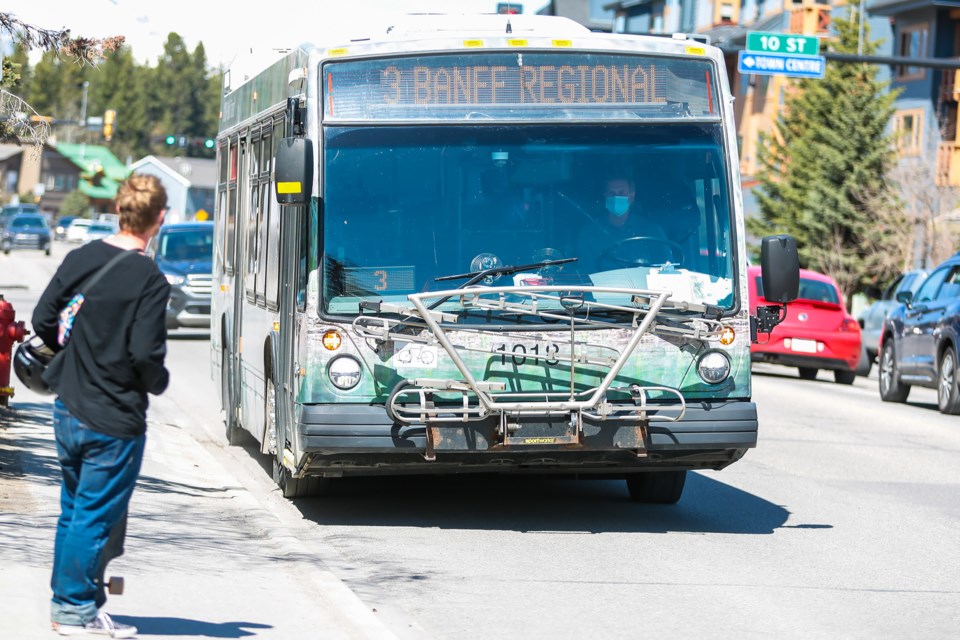BANFF – As Roam Transit continues to grow, the Bow Valley Regional Transit Services Commission will have a number of factors to consider before finalizing the upcoming budget.
Two new staff positions will be examined, while a completed external compensation review will lead to an internal one being completed in 2022 for a potential wage increase. The commission also increased the starting vacation time from two to three weeks for new staff and up to a maximum of five during a calendar year, effective 2022.
At an August meeting, Roam staff presented the preliminary 2022-23 operating and capital budgets, which despite the new additions, will likely see little financial increase for the regional transit service.
Martin Bean, Roam Transit’s CAO, called it a “status quo budget,” and based on the assumption a return to pre-pandemic service hours would return.
The proposed operating budget for 2022 is $6.56 million – prior to the additions from the August meeting – and the transit service is budgeting an income of $2.96 million in income before requisitions, which when added bump it to $7.08 million.
The commission will decide the final budget at its September meeting.
Among the main expenses are fuel at an estimated $644,752, vehicle expenses of $1.35 million and wages and benefits of $3.78 million.
A full-time human resources coordinator role for an estimated $64,000 annually was included as part of the 2022-23 operating budget. Roam Transit operates seven days a week, 20 hours a day and has more than 80 people on staff.
A staff report highlighted HR matters are done by existing staff, seeking advice from the Towns of Banff and Canmore and the help of an external consultant – Elevated HR Solutions – for $1,000 each month.
The role was necessary due to Roam Transit’s growth and the resulting paperwork, recruitment, training, employee relations and understanding HR legislation.
“Our people are our greatest asset… it is critical that the organization invests more into employee engagement and culture within the organization,” the report stated.
A part-time dispatch coordinator will also be looked at in the budget. If approved, it would assist with the increase of services with service hours growing from 19,800 in 2016 to an estimated 54,500 this year.
The role is designed to be 60 per cent dispatch and 40 per cent driving for a total of $77,200, but the cost to the commission will be $46,400 due to a funding split between Roam and Parks Canada routes.
Bean said for four months of the year they need an extra 30 to 40 employees for the busy summer months after hiring 25 drivers this summer.
“The seasonality is the challenge and it’s going to continue to be an increased challenge,” he said, adding it will also free up Roam's transit systems specialist for other duties and provide relief for drivers.
If the new positions are approved within the final budget, including with the increase in driver vacation, it would add an estimated $145,000 to the budget.
The external compensation review found Roam Transit was on par for pay with comparative transit agencies, but behind larger centres such as Calgary and Edmonton. However, the report found Roam Transit paid higher than other transit providers in the Bow Valley.
The analysis examined other transit payment rates in Edmonton, Calgary, Red Deer and Southland Transportation, with Pursuit declining to participate.
It noted Edmonton and Red Deer drivers are in the same union and are both paid a shift differential from 6 p.m. to 6 a.m. The vacation pay for the four areas varies from four to 14 per cent, while the starting rate is between $21.09 to $28.78. The maximum rate increases up to between $23.59 and $36.51.
“We feel the benefits and pay are above others in the valley. However, we’re definitely below what city transit organizations are paying,” Bean said, adding the biggest challenge was getting drivers for the full year. “I think we’ll always be somewhat below since we attract people who want to be out in the mountains and we offer them a good job while they’re here. We’re pretty comfortable with most of the things in our compensation package other than our vacation allotment.”
The report also highlighted the differences in living wage, with Edmonton at $16.51 an hour and its transit providing 41 per cent above that and Calgary being at $18.15 an hour and transit pay being 37 per cent above. For the Bow Valley, the living wage was $19.50 and drivers are paid 30 per cent above that rate.
However, the living wage included if all drivers had access to affordable housing, which without, would up it to $30.97 an hour.
The report included six recommendations to increase training wages for drivers, provide a safe driving record bonus, increase vacation time pay and possibly adding a shift differential.
The staff report echoed the consultants by recommending vacation time be increased from two to three weeks when starting and up to a maximum of five weeks. Staff also recommended the commission direct staff to complete a compensation review by February 2022.
“Employee satisfaction and attraction is affected by this and Roam needs to ensure that we are doing everything possible to attract and retain employees,” the staff report stated. “Retaining employees by providing a strong compensation package and an enjoyable workplace atmosphere will reduce operational and training costs as well as increasing operational excellence.”
A previous decision by the commission led to drivers getting a $1 per hour increase and automatically starting at two weeks vacation. Since Roam Transit is not unionized, all drivers receive the same rate regardless of their tenure.
“We’ve had drivers leave and then go to a large transit agency and come back because it’s a completely different job dealing with different types of people in a different location,” Bean said. "A lot of it is due to union agreements. We pay above the valley along with good benefits to keep people happy.”




